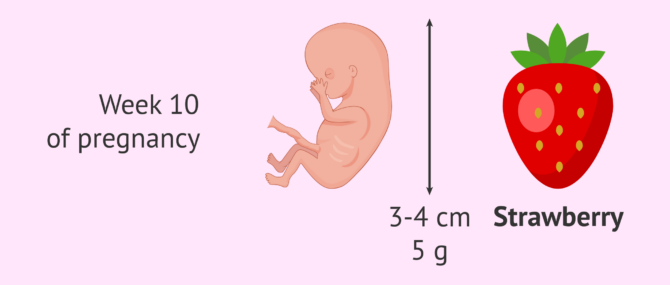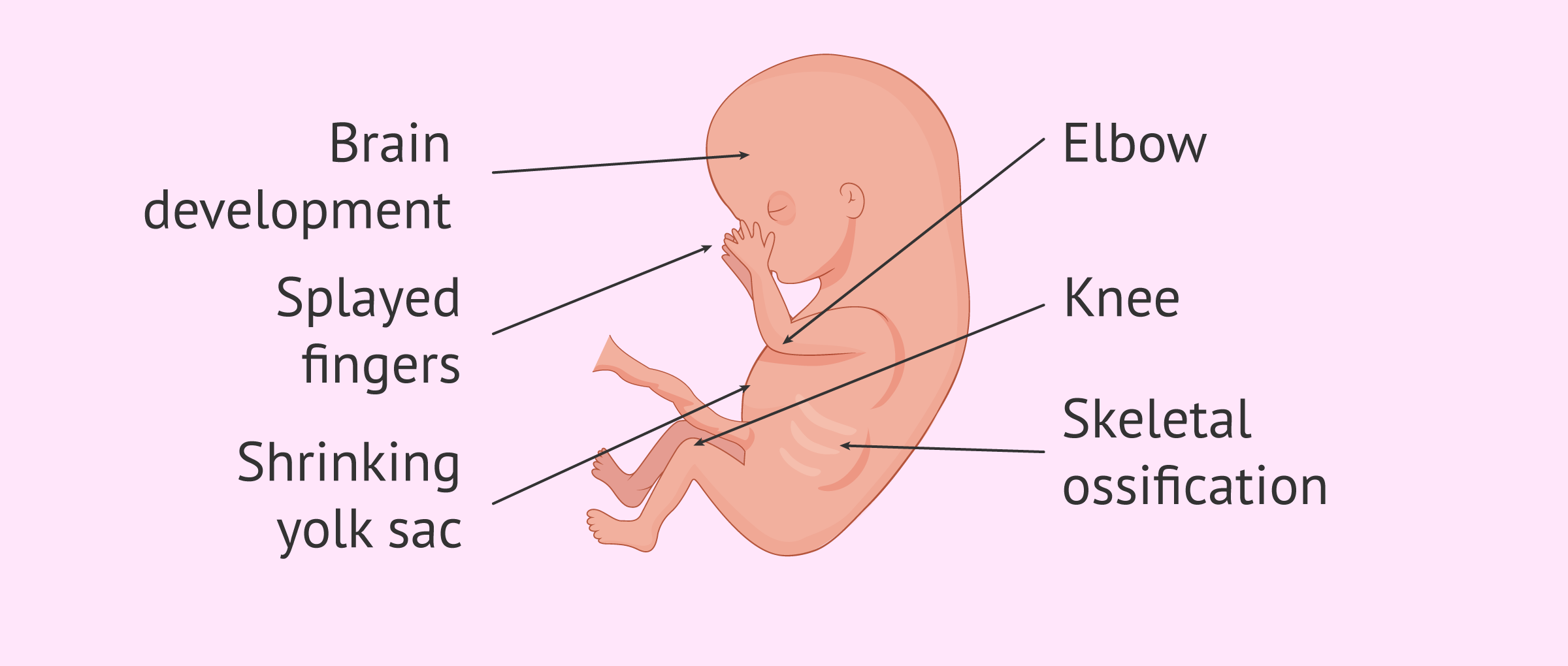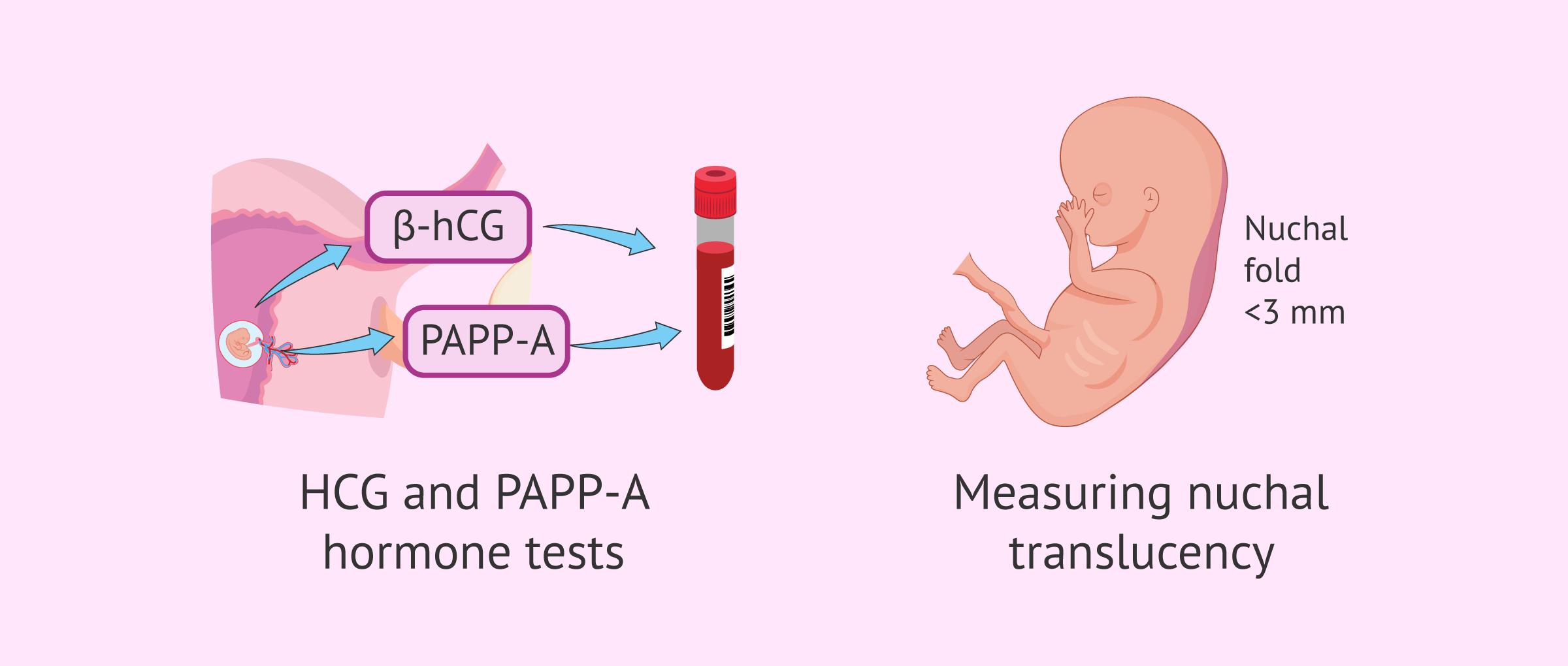Week 10 of pregnancy is in the middle of the third month, almost at the end of the critical first trimester.
At this moment, the fetal stage begins, that is, the embryo is called fetus, which already has all its basic systems formed.
As for the woman, her pregnancy still goes unnoticed by the rest of the people at 10 weeks, but she may already notice a swollen belly and a slight weight gain.
Provided below is an index with the 8 points we are going to expand on in this article.
- 1.
- 2.
- 3.
- 3.1.
- 3.2.
- 4.
- 5.
- 5.1.
- 5.2.
- 5.3.
- 6.
- 7.
- 8.
Growth of the fetus
At the 10th week of pregnancy, the embryo is called a fetus until the date of its birth. It measures approximately 3-4 cm and weighs about 5 grams.
The body of the fetus is already more elongated and begins to look more like a human. He is also very active, kicking his legs and swallowing amniotic fluid constantly.
Other important changes in the fetus during this tenth week are as follows:
- The forehead is large relative to the size of the face due to brain development.
- The tongue, palate and tooth primordial begin to form.
- The elbows appear first and then the knees, while the limbs become longer.
- Fingers and toes separate and nails appear.
- The little hands are constantly opening and closing.
- Lanugo appears: very fine hair covering the skin.
- The anus and urethral groove are formed.
- Ossification of the skeleton begins, i.e., the bones accumulate calcium.
- The sexual organs begin to differentiate.
- The yolk sac is shrinking because the placenta is fully functioning.
Symptoms in the mother
By the tenth week of pregnancy, the uncomfortable symptoms of the first few weeks, such as nausea and vomiting, may begin to subside.
Major changes in the woman's body have not yet occurred, but she will begin to notice that her clothes are tighter around her waist. The uterus has increased considerably in size and occupies a large part of the pelvis.
On the other hand, an important change this week is that the breasts increase in size. It is important to buy a special bra for pregnant women at this point, as it will help to avoid back problems.
Other characteristic symptoms in week 10 of pregnancy include the following:
- Increased salivation
- Gases
- Spider veins on the legs due to dilation of blood capillaries
- Weight gain of 1 or 2 kg
- Swollen belly above the pubis
- Slight discomfort from stretching of the placenta
- Frequent urination
Finally, the mood usually improves from this week onwards thanks to the body's adaptation to the gestational state and the decrease of bothersome symptoms.
Most pregnant women report that they really start to enjoy their pregnancy from week ten onwards.
Pregnancy control
It is important to make a first visit to the gynecologist if you have not already done so in week 10. In the ultrasound it will be possible to take measurements of the fetus, visualize the fetal structures and listen to its heartbeat.
From this moment on, the follow-up of the pregnancy begins. The gynecologist takes into account all the woman's history to include it including her history: of previous pregnancies, possible miscarriages, prominent symptoms, etc.
Assisted procreation, as any other medical treatment, requires that you rely on the professionalism of the doctors and staff of the clinic you choose. Obviously, each clinic is different. Get now your Fertility Report, which will select several clinics for you out of the pool of clinics that meet our strict quality criteria. Moreover, it will offer you a comparison between the fees and conditions each clinic offers in order for you to make a well informed choice.
It is also very important to control the mother's weight and blood pressure, measures that will be taken at each gynecological check-up.
Depending on the characteristics of the pregnancy, the mother's age, risk of miscarriage or other aspects, it will be necessary to monitor the pregnancy more or less strictly. However, the tests discussed below are performed in all pregnancies today.
Blood tests
During the course of the first trimester of pregnancy, a blood test is necessary in order to check the following parameters:
- Mother's blood group.
- Possible anemia due to lack of iron.
- Serologies to know if the mother has passed infectious diseases such as hepatitis, syphilis, toxoplasmosis or rubella.
In case of any altered result, the gynecologist will take the appropriate measures so that there is no risk to the mother or the fetus. It is very important to treat infections so that they do not pass to the fetus.
This first blood test also determines other proteins necessary for the so-called biochemical screening, which we will discuss below.
Combined first trimester screening
This prenatal diagnostic test is also known as triple screening and is usually performed between 10 and 12 weeks of pregnancy.
It consists of estimating the risk probability that the fetus is affected by Down syndrome or other chromosomal disorders.
To perform this combined screening, it is necessary to perform a maternal blood draw and an ultrasound to obtain the following parameters:
- Pregnancy-associated placental protein: PAPP-A
- Free beta-hCG values
- Nuchal translucency of the fetus
Normally, the blood test is done first around week 8 or 11, followed by the ultrasound at 12 weeks gestation. However, there are cases in which both studies are carried out jointly.
These 3 parameters are taken into account together with the age and weight of the pregnant woman at the time of testing and ultrasound to calculate the risk probability.
Since this test is only an estimation, if a result is obtained that indicates a possible risk, it is advisable to perform an amniocentesis or chorion biopsy to confirm that there is indeed a chromosomal alteration.
Care
From this moment of gestation, the woman will begin to notice more the growth of the fetus inside her, either by weight gain or back discomfort. It is very important to practice sports suitable for pregnant women in order to maintain good physical condition and combat possible pain.
Feeding is also key to the baby's proper development, as the baby takes nutrients, vitamins, and minerals from the mother through the blood that flows through the placenta and the umbilical cord.
Below, we will discuss all the recommendations for a healthy pregnancy from week 10 onwards:
- Healthy and balanced diet with the necessary intake of folic acid, calcium, iron and vitamin C.
- Eat at least 5 meals a day and in small quantities to improve digestion.
- Chew food well and slowly to avoid gas.
- Drink water frequently for proper hydration.
- Wear loose-fitting clothes to be more comfortable.
- Buy a larger size bra, preferably without underwire and with cotton.
- Walk at least half an hour a day to combat fatigue and improve circulation.
- See your health care provider if you experience any bleeding or have symptoms of a urinary tract infection.
FAQs from users
How can I tell if I am pregnant with twins at week 10?
The most advisable thing to do is to do an ultrasound to be able to see the number of gestational sacs and fetuses that there are. It will also be possible to hear the heartbeat of two fetuses in the ultrasound.
On the other hand, women with multiple pregnancies notice a greater weight gain when they reach week 10, as well as an elevation of the lower part of the belly. The symptoms are also usually more noticeable than in other women: more sensitive breasts, more nausea, etc.
How many months are 10 weeks of pregnancy?
The 10 weeks of pregnancy correspond to the third month. Exactly, the woman would be 2 and a half months.
However, it should be noted that the gestational age of the fetus is 8 weeks, i.e. 2 months.
How is the baby at 10 weeks of pregnancy?
The baby's body is already formed at ten weeks gestation and resembles that of humans. It is 3 to 4 cm long, has a large head, and the arms and legs have already lengthened. It is also possible to intuit its facial features: the eyes have formed, although they are closed by the eyelids, the nose is more prominent and the ears and mouth have also formed. Finally, the baby can now move its limbs and open and close its hands.
Recommended readings
If you are 10 weeks pregnant, you will be interested to read the following article soon: Eleven weeks pregnant.
Bleeding in week 10 of pregnancy can indicate different things. For more detailed information We recommend that you read the following post: Bleeding during pregnancy.
We make a great effort to provide you with the highest quality information.
🙏 Please share this article if you liked it. 💜💜 You help us continue!
References
Antoni Borrell, Julian N Robinson, Joaquin Santolaya-Forgas. Clinical value of the 11- to 13+6-week sonogram for detection of congenital malformations: a review. Am J Perinatol. 2011 Feb;28(2):117-24. doi: 10.1055/s-0030-1263302 (View)
A Syngelaki, A Hammami, S Bower, V Zidere, R Akolekar, K H Nicolaides. Diagnosis of fetal non-chromosomal abnormalities on routine ultrasound examination at 11-13 weeks' gestation. Ultrasound Obstet Gynecol. 2019 Oct;54(4):468-476. doi: 10.1002/uog.20844 (View)
K H Nicolaides, V Heath, A W Liao. The 11-14 week scan. Baillieres Best Pract Res Clin Obstet Gynaecol. 2000 Aug;14(4):581-94.
K O Kagan, I Staboulidou, A Syngelaki, J Cruz, K H Nicolaides. The 11-13-week scan: diagnosis and outcome of holoprosencephaly, exomphalos and megacystis. Ultrasound Obstet Gynecol. 2010 Jul;36(1):10-4. doi: 10.1002/uog.7646 (View)
FAQs from users: 'How can I tell if I am pregnant with twins at week 10?', 'How many months are 10 weeks of pregnancy?' and 'How is the baby at 10 weeks of pregnancy?'.
Authors and contributors
More information about Cristina Algarra Goosman









Hello, this is my first pregnancy and I am 10 weeks pregnant. I wanted to know if it is normal not to feel nausea. I have been waiting for the morning sickness but I feel just fine. Does this mean there is something wrong with my baby? TIA
Hello Samijo,
Pregnancy symptoms, which are usually more intense in early pregnancy are not always present in all pregnant women. While some women notice nausea, others may have breast tenderness or fatigue.
Not having or having these symptoms in greater or lesser intensity is not indicative of the baby’s health. If the doctor does not see any problems in ultrasounds or routine check-ups, you should not worry.
I hope everything is going well,
Best regards
Hi, at the first ultrasound they told me they saw the sac but not the baby. I was also told that it could be a pregnancy without an embryo or that it was too small to be seen. Is this true?
Hello cecestanley,
In the early weeks of pregnancy, the embryo cannot be seen on ultrasound. At first, the gestational sac will be observed and from the eighth week, the fetus will be seen.
If you have had an ultrasound in which the fetus was not visible, it is important to take into account when the ultrasound was performed (if it was before week 8), if so, the doctor will recommend repeating the test after a few weeks to see if growth can be observed.
On the other hand, it is possible that the pregnancy is anembryonic in which there is no presence of an embryo and therefore is not viable.
I leave you this article so you can read more about it: Anembryonic pregnancy.
I hope I have helped you,
Best regards